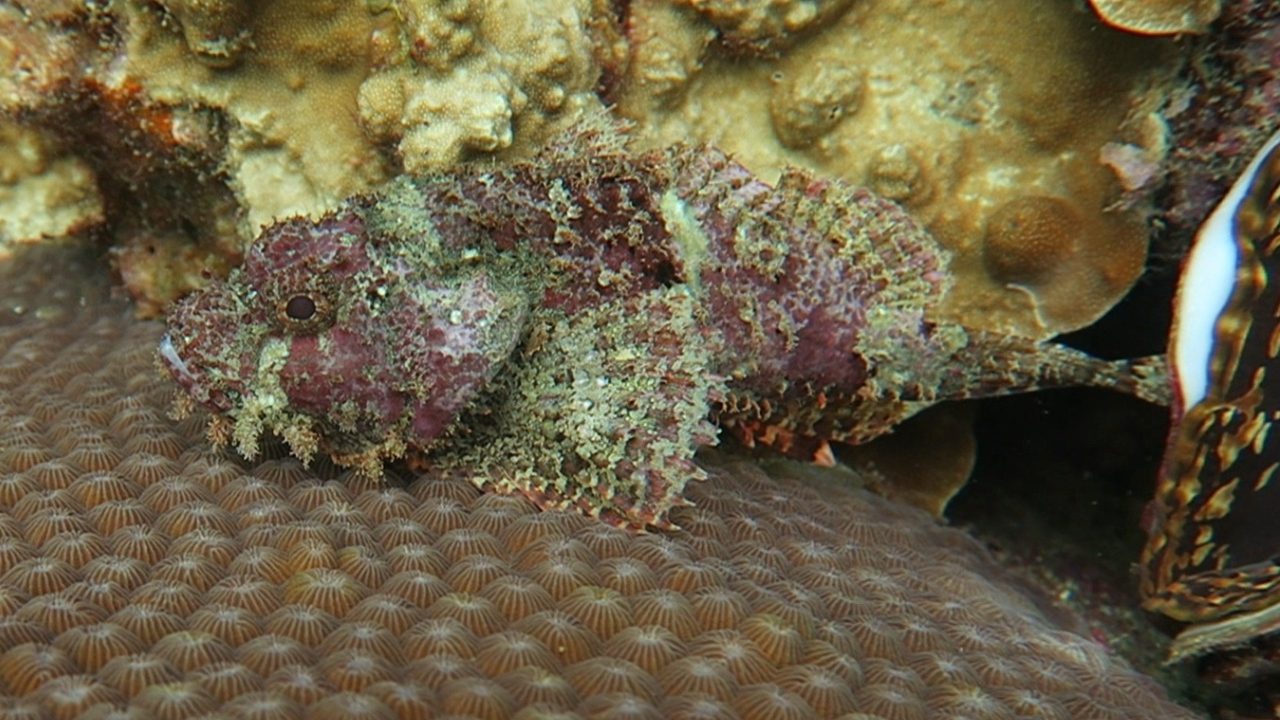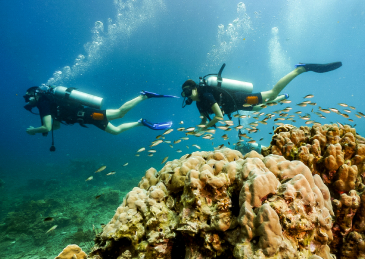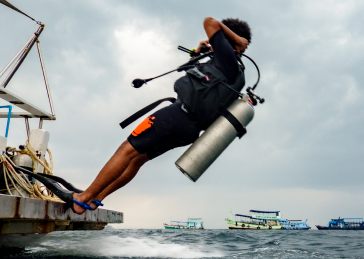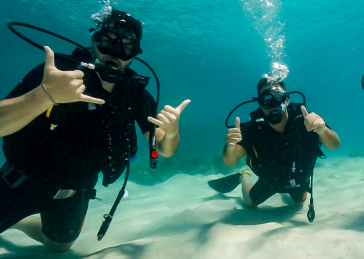Modified 9th June 2025
The Elusive Bearded Scorpionfish of Koh Tao: Masters of Camouflage
Among the remarkable marine life inhabiting Koh Tao’s waters, few creatures demonstrate such extraordinary camouflage abilities as the Bearded Scorpionfish. These masters of disguise are so expertly adapted to their environment that even experienced divers consider spotting one a significant achievement. Their exceptional ability to blend seamlessly with their surroundings makes them one of the most challenging and rewarding marine species to encounter for underwater photographers and marine life enthusiasts.

The Bearded Scorpionfish Koh Tao (Scorpaenopsis barbata) is the primary scorpionfish species regularly encountered around the island. This fascinating creature belongs to the Scorpaenidae family, which includes over 400 species of venomous fish including lionfish and the deadly stonefish. What distinguishes the Bearded Scorpionfish are the distinctive fleshy outgrowths under its chin that resemble a spiky beard, giving this remarkable fish its common name.
Visual Identification Guide
| Feature | Description |
|---|---|
| Scientific Name | Scorpaenopsis barbata (also known as Tasselled Scorpionfish) |
| Size | Up to 36 cm in length, though typically smaller around Koh Tao |
| Coloration | Deep red to brown with black and white blotches that match local coral |
| Distinctive Features | Fleshy outgrowths under chin (“beard”), wart-like protrusions, flattened elongated body |
| Venomous Parts | Spines along dorsal, pelvic, and anal fins contain potent venom |
| Best Identification Method | Look for reflective eyes and slightly spread pectoral fins stabilizing on rocks |
Appearance and Behavioral Characteristics
The Bearded Scorpionfish features a flattened, elongated body that typically reaches 30-36 cm in length around Koh Tao’s dive sites. Their coloration ranges from deep red to brown with black and white blotches scattered across their body, creating a variable pattern that allows them to blend perfectly with rocks, coral formations, and the ocean floor. Adding to their remarkable camouflage are numerous wart-like protrusions and featherlike fins that break up their outline and make them nearly indistinguishable from the substrate they rest upon.
Perhaps the most distinctive feature of these remarkable fish is their large eyes, which often serve as the primary giveaway for divers attempting to spot them. These eyes, positioned high on their head, allow the scorpionfish to maintain constant vigilance while the rest of their body remains perfectly concealed. Their mouth is disproportionately large compared to their body size, enabling them to swallow prey whole in a split second using powerful suction.
Interactive Scorpionfish Spotting Quiz
Test Your Scorpionfish Knowledge
How well do you know the techniques for spotting Bearded Scorpionfish Koh Tao? Take this quick quiz to find out!
Hunting Behavior and Feeding Patterns
Bearded Scorpionfish are ambush predators that rely on patience and exceptional camouflage rather than speed or agility. They typically position themselves motionless on rocks or coral formations, often in areas that perfectly match their natural coloration, and wait for unsuspecting prey to swim within striking distance. When a potential meal approaches, they employ their mouth as a powerful vacuum, creating intense suction that draws in prey within milliseconds.

These patient hunters feed primarily on smaller fish, crustaceans, and cephalopods that venture too close to their hiding spots. Their hunting strategy is remarkably energy-efficient, with very little energy expended until the precise moment of attack. This sedentary lifestyle contributes to their ability to remain in one specific location for extended periods, further enhancing their chances of successful camouflage and hunting success.
Despite their fearsome hunting abilities underwater, Bearded Scorpionfish are not aggressive toward divers and actually prefer to remain completely motionless even when closely approached. However, their venomous spines demand respect and caution from all who encounter them during Koh Tao marine life adventures.
Venomous Nature and Essential Safety Protocols
Like all members of the Scorpaenidae family, Bearded Scorpionfish possess venomous spines along their dorsal, pelvic, and anal fins. While less potent than stonefish venom, scorpionfish stings can cause intense pain, swelling, and systemic symptoms. Always maintain visual contact with your surroundings and never touch marine life.
The venom of the Bearded Scorpionfish, while considerably less potent than that of the deadly stonefish, can still cause intense pain, significant swelling, and in severe cases, systemic symptoms throughout the body. The primary danger arises when divers accidentally touch or handle these perfectly camouflaged fish, mistaking them for rocks or coral formations during their underwater exploration.
If a sting occurs during your dive, the recommended first aid treatment involves immediately exiting the water safely and immersing the affected area in water as hot as can be tolerated without causing burns (around 45°C/113°F) for at least 30-90 minutes. The heat helps to break down the protein-based venom, reducing pain intensity and limiting tissue damage. However, medical attention should always be sought following any scorpionfish sting, particularly if symptoms worsen or spread beyond the initial sting site.
Prevention Tips for Divers
- Always maintain excellent buoyancy control to avoid accidental contact
- Use proper hand signals and avoid touching any marine life
- When positioning yourself underwater, check the area by gently waving your hand near (but not touching) potential resting spots
- Use a torch during day dives to spot reflective eyes
- Maintain awareness of your fins and where you’re kicking
- Choose experienced dive guides familiar with local marine life
Prime Dive Sites for Scorpionfish Encounters
For those eager to spot these elusive masters of disguise, several dive sites around Koh Tao offer enhanced chances of encounters with Bearded Scorpionfish:
This magnificent twin pinnacle near Koh Nang Yuan provides excellent rocky terrain where scorpionfish blend perfectly with the natural formations. The varied depths and excellent visibility make it ideal for careful observation.
The artificial reef created by this sunken naval vessel provides numerous nooks and crannies where scorpionfish can blend seamlessly with the growing marine growth and metal structures.
This shallow, beginner-friendly site hosts several resident scorpionfish that have been observed in the same general locations for extended periods, making it excellent for new divers.
The varied terrain and diverse rock formations at this popular dive site create ideal habitats for scorpionfish, with multiple depth ranges to explore.
This site occasionally rewards observant divers with scorpionfish sightings among the rocky structures, particularly around the deeper sections.
Advanced divers can explore the deeper sections where larger scorpionfish are occasionally spotted among the dramatic rock formations.
The most effective approach to spot a Bearded Scorpionfish is to scan slowly and methodically, specifically looking for their distinctive reflective eyes or the slightly spread pectoral fins they use to stabilize themselves on rocks. Using a dive torch, even during bright daytime dives, can help reveal their position as the light reflects off their eyes. Diving with experienced local guides significantly increases your chances of encountering these masters of camouflage, as they often know specific rocks or areas where scorpionfish have been repeatedly sighted over time.
Professional Photography and Observation Techniques
Finding a well-camouflaged scorpionfish requires patience, keen observation skills, and a methodical underwater approach. Expert divers recommend these proven techniques for successful spotting:
- Move slowly and scan thoroughly: Quick movements significantly reduce your chances of spotting these stationary masters of disguise
- Focus on eyes: The most visible feature of a camouflaged scorpionfish is often its reflective eyes, which stand out against textured backgrounds
- Use a torch strategically: Even during bright daylight dives, a torch can help reveal scorpionfish by creating reflections from their eyes or highlighting subtle texture differences
- Check optimal habitats: Focus your search on rocky outcroppings, especially those with coloration similar to the fish (reddish-brown to deep brown tones)
- Observe pectoral fin positioning: Scorpionfish often spread their pectoral fins slightly to stabilize themselves on rocks, creating a subtle but recognizable shape
For underwater photographers, scorpionfish present unique challenges and exceptional opportunities. Their stationary nature makes them excellent subjects once successfully located, but their effective camouflage can make achieving proper focus and composition quite difficult. Professional photographers recommend these specialized techniques:
- Use a focus light to help your camera’s autofocus system lock onto the subtle details and textures of the fish
- Include surrounding environment in your composition to showcase the remarkable effectiveness of their natural camouflage
- Shoot from slightly above or at eye level with the fish to capture their distinctive facial features and prominent eyes
- Avoid using overly strong strobes that might stress the animal or cause it to abandon its chosen position
- Take multiple shots with different focus points to ensure sharp detail capture
Ready to search for these elusive masters of camouflage? Join La Bombona Diving for the best chance to spot Bearded Scorpionfish during your Koh Tao adventure!
Our experienced dive guides know exactly where to look and will teach you the techniques to spot these incredible creatures safely.
- Expert local guides with extensive scorpionfish knowledge
- Access to the best dive sites for marine life encounters
- Small group sizes for personalized attention
- Professional safety protocols and equipment
- Detailed marine life briefings before each dive
- Underwater photography guidance and tips
Fun Diving: ฿2,000 for 2 dives – Perfect for scorpionfish spotting adventures
Book Your Scorpionfish Adventure4-hour trips | Morning or afternoon options | All equipment included
Conservation Status and Ecosystem Importance
Marine Conservation Role
While specific population data for Bearded Scorpionfish around Koh Tao remains limited, they face the same environmental challenges affecting all marine life in the region. As ambush predators occupying a crucial mid-level position in the reef’s food chain, scorpionfish play an important role in maintaining the delicate balance of reef fish populations.
These remarkable creatures face several environmental challenges that affect their long-term survival around Koh Tao:
- Habitat degradation: Coastal development and anchor damage affect their preferred rocky habitats
- Climate change impacts: Rising water temperatures and ocean acidification threaten coral reef ecosystems
- Overfishing effects: Depletion of prey species in surrounding waters impacts their food sources
- Marine pollution: Plastic waste and chemical contamination affect the entire marine food chain
Their presence in healthy numbers indicates a balanced reef ecosystem with sufficient prey species and suitable habitat conditions. By choosing environmentally responsible dive operators and practicing excellent buoyancy control along with other sustainable diving techniques, visitors to Koh Tao can help ensure that future generations of divers will have the opportunity to search for and marvel at these incredible masters of disguise. Learn more about marine conservation efforts in Koh Tao and how divers can contribute to protecting these remarkable creatures.
Frequently Asked Questions About Bearded Scorpionfish Koh Tao
For divers and marine life enthusiasts exploring Koh Tao’s underwater realm, few discoveries are as genuinely rewarding as successfully spotting a perfectly camouflaged Bearded Scorpionfish. These remarkable masters of disguise offer a glimpse into the incredible adaptations that have evolved in the marine environment and remind us of the wonders that await those patient and observant enough to look beyond the obvious.
By understanding their behavior, habitat preferences, and the techniques for safely observing them, visitors to Koh Tao can add the elusive Bearded Scorpionfish to their list of memorable underwater encounters in Thailand’s tropical waters. Whether you’re a beginning diver taking your first Open Water course or an experienced underwater photographer, these fascinating creatures represent one of the ocean’s most remarkable examples of evolutionary adaptation and survival strategy.
Planning your scorpionfish spotting adventure? Learn about getting to Koh Tao from anywhere in Thailand and discover more about the incredible marine life diversity that awaits your underwater exploration around this world-renowned diving destination.
Bucea con LBD: tu puerta a la exploración submarina
Whether you’re a curious beginner or a seasoned pro, our school is your portal to the wonders of scuba diving. Join us into the world beneath the waves.
¿LISTO PARA EMPEZAR?
Consulta nuestros cursos de buceo en Koh Tao



